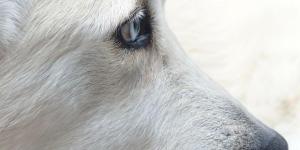How to Cheer Up a Sad Dog



See files for Dogs
Although some play down canine emotions, dogs can get sad. They do not have the same emotional capacity as humans, but dogs can get depressed due to various emotional or even physical problems. Such sadness will be manifested in various symptoms, including lethargy, withdrawal and even aggression in pronounced cases. It is important to remember that dogs will not get depressed for no reason. Whether it is a change in their physical organism or an emotional reaction to environmental change, we need to be sensitive to our dog's well-being.
At AnimalWised, we explain how to cheer up a sad dog. While serious depression in dogs will need clinical veterinary treatment, there are some things we can do at home when our dog has a mild case of the blues.
Why is my dog sad?
Sadness is a basic emotion that is not exclusive to humans. Healthy dogs in a secure environment that have their basic needs met will generally be very happy. However, even a happy dog can experience depression in the right circumstances. Such sadness can be the result of emotional trauma such as losing a loved one, but it can also be due to less obvious causes.
Even in situations where it seems appropriate, it is important to remember that sadness is an involuntary response which is unpleasant for the animal. While a dog can easily overcome a short period of depression, prolonged sadness can have deleterious effects on the animal's well-being. For this reason, it is essential that a guardian isolate the cause of their depression. Possible signs a dog is sad or depressed include the following:
- Sudden changes in their environment: dogs are creatures of habit that generally need routine to feel secure. How strict this routine will be depends on the needs of the individual. Moving home, changes in the family dynamic are likely to cause disturbance to any dog. More sensitive dogs may become sad due to relatively minor changes such as redecorating the home or changing their food brand.
- Pain: a very common cause of apathetic behavior is the appearance of some type of ailment. When a dog is not feeling well, they often refuse to eat and spend a lot of time lying down, which can give the impression the dog is depressed. Since dogs are good at hiding the signs of pain, it is important not to discount a physical problem as a reason the dog is sad.
- Inconsistent or punishment-based education: properly educating a dog is a complex process that requires up-to-date knowledge about canine behavior and language. It also requires patience and empathy. When guardians are inconsistent in their training, reinforce negative behaviors or use physical or emotional punishment, the dog can become scared, confused and sad, usually characterized by apathy.
- Negative or traumatic experiences: negative experiences that cause fear in the dog can result in a subsequent mood that can be interpreted as sadness. This could be something that occurred in their past such as maltreatment or neglect, something which can be difficult to determine when adopting adult dogs. Others can be new experiences such as being attacked by another animal when out walking.
These are some general causes, but it is important to remember that each dog is unique. They will have their own circumstances and influences which can result in sadness. It is also important to distinguish between emotional sadness and related issues such as boredom. Learn more with our article on how to know if a dog is bored.
How to cheer up a sad puppy
When you see your dog is experiencing prolonged periods of depression, you will need to take them to a veterinarian. They can asses them and perform the appropriate diagnostic tests. They will then advise on treatment, as well as refer to a canine ethologist or dog trainer if the animal needs some further cognitive support.
After assessment, it is important to know that there are general factors you need to consider in your dog's happiness. These tips are specific to the dog's individual needs, something which is determine by various criteria. One of the most important is their age, with puppies needing different types of care compared to adult dogs.
Puppies are fun, mischievous and playful by nature. They are also very sensitive, often feeling overwhelmed and confused upon arrival in a new home. Being separated from their mother and/or siblings and leaving behind everything they know represents a very abrupt change in their life. This can lead the animal experiencing a feeling of anxiety or sadness.
Puppies sometimes whine and act scared during the first few days they spend with their new family, especially at night. This is often more pronounced in puppies that have been separated too early from their mother, i.e. before the age of 8 weeks. In order to help them in their adaptation process, it is essential to spend time establishing a bond and making them feel safe. This will teach them over time that they can fully trust you.
Some recommendations to cheer up a sad puppy are:
- Do not leave them alone for too long when they are still very young, there will be time to teach him to tolerate being on their own.
- Play with them frequently, but for small periods of time. This will help to prevent them from getting overly tired and reducing the benefit.
- Don't punish them for chewing furniture or peeing in inappropriate places. They are learning, so you will need to guide them and teach alternative behaviors. You should redirect bad behaviors and reinforce positive ones.
- Respect their rest periods, something especially important when they are young. Puppies must sleep for many hours, do not wake them up or disturb them unnecessarily.
- Spend some time together relaxing, cuddling and being affectionate. While running and playing are important, it is vital they learn boundaries and when it is time to be quiet.
- Don't be in a hurry to teach them obedience tricks. At a young age it is more important to teach them to socialize and let them explore their new environment.
- Gradually accustom them to the sounds, smells, objects and people they will encounter throughout their lives. This will best prevent them from acquiring fears and phobias of the unknown.
- Make sure you provide them with a quality diet, adapted to their weight, age and any other pertinent factors such as health status.
How to cheer up a sad adult or senior dog
When we adopt an adult dog into our home, we should know that their socialization can be more difficult. This is due to their past experiences being potentially traumatic or providing other difficulties. A common example is a lack of or poor socialization. When we adopt a dog in this state, we need to be careful with introducing and adapting them to their new home. We may see them exhibit signs of sadness or anxiety.
Patience is one of the most import components in cheering up a sad dog. Let the animal adapt at their own pace and do not force interactions. Many concerned guardians will want to intervene to let them know they are welcome, but this can be stifling for the dog and they may become even more self-conscious.
Even if we are well meaning, it is important not to harass or overwhelm the dog. You will need to read the dog's body language and wait until they come to your for affection. When this happens, you can slowly start to introduce play and give them affection, but you should retreat if they show any signs of unease.
There are circumstances when a dog is suddenly sad after being happy in the home. In these cases, we will need to follow these steps:
- Analyze their health status. Check and touch areas over their entire body, including legs, snout, mouth, ears, etc. We will need to gauge their response in case they have a painful wound or even a foreign body lodged somewhere.
- If they don't seem to have any health problems, try offering an activity that you know they enjoy. For example, bring the leash and propose a walk. If they show no interest, it means they are feeling emotionally upset.
- Talk to them slowly, never yell or force them to do anything they don't want to. They need reassurance at this time.
- If none of the above works, let your dog rest and try again later.
Also keep in mind that older dogs do not have the vitality and energy of a young dog. It is normal for senior dogs to spend more time lying down and resting, even if they were once very active. In addition, some pathologies affect older animals more frequently. These include osteoarthritis or cognitive dysfunction syndrome in older dogs. This can make them seem sad or depressed, but their lethargy has a physical origin.

My dog is still sad, what do I do?
In the event that you cannot cheer up your puppy or your adult dog, you should go to a veterinary center to have them evaluated by a professional. There may be a physical health problem which we cannot detect from their evident symptoms. They will perform the relevant tests and carry out the appropriate corrective treatment.
If the diagnosis is negative and your dog is physically healthy, then you should consider contacting a canine ethologist or dog trainer. They will be best suited to assess the dog's individual needs and determine the root cause of their sadness. They will be able to help in providing practical training and education to help cheer them up. This way, they can provide guidelines for you to follow.
Keep in mind that sometimes guardians may confuse sadness with a behavioral problem. An ethologist will not only assess the dog, but also the care the guardian provides. This way, we can redress the problem. For example, we may be leaving them alone for too long, resulting in the dog experiencing separation anxiety. They may be understimulated and need some environmental enrichment to keep them cognitively healthy.
If you want to learn more about why your dog is sad and how you can cheer them up, take a look at our video below:

This article is purely informative. AnimalWised does not have the authority to prescribe any veterinary treatment or create a diagnosis. We invite you to take your pet to the veterinarian if they are suffering from any condition or pain.
If you want to read similar articles to How to Cheer Up a Sad Dog, we recommend you visit our Mental problems category.






